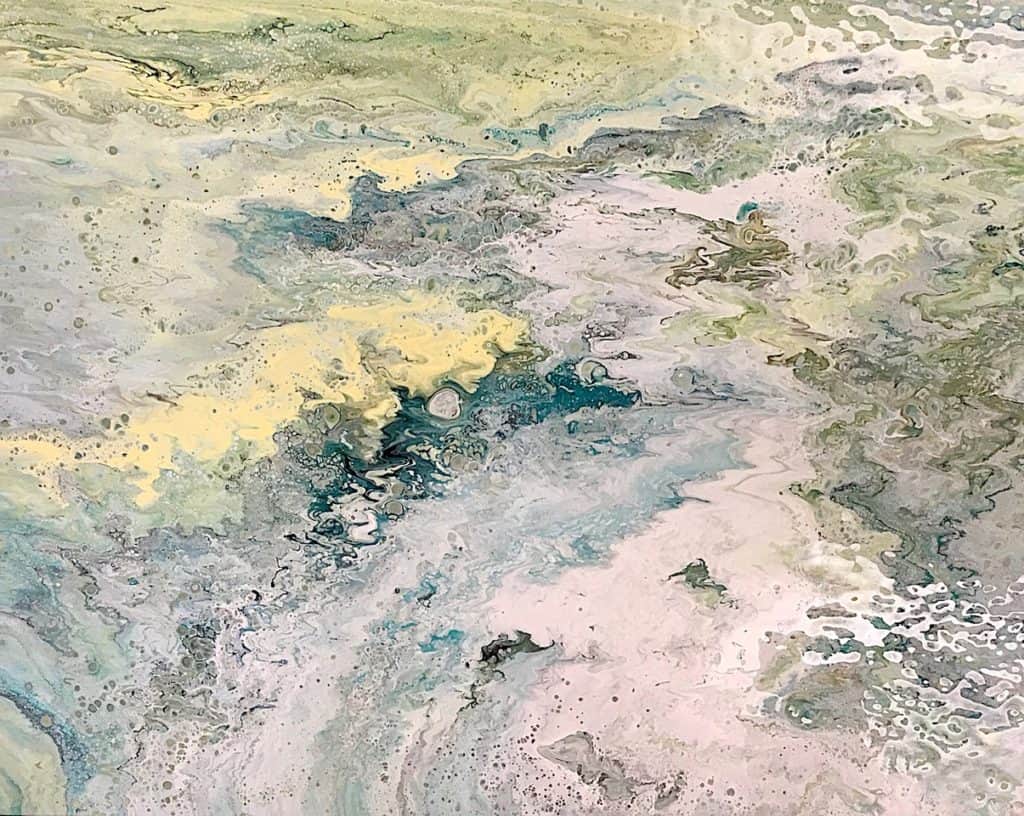This painting was so much fun to make, and I hope that comes through in the video! The canvas is really big—24 by 30 inches. That’s over four square feet of acrylic pouring!
The painting was a commissioned piece intended as a gift for a good friend’s mother. As you’ll see in the video, creating a painting on that large of a scale presented a few challenges.
Supplies I Used
- Paint by FolkArt. The six colors used were: Black, Teal, Wicker White, Platinum, Chick, and Marina Mist.
- Silicone by 3in1 (In the video I mistakenly call it “3in1silicone oil.” It is actually just silicone made by the 3in1company)
- Zinsser Paint Booster (a.k.a., Zinsser Flow Control Additive)
- Water (In Atlanta, I use the water right out of the faucet, but you may need to use bottled water.)
- 24×30 inch canvas
Typically I use a paint box to catch the paint that drops off the sides of a canvas, and most of my paintings are 16×20 inches or smaller, which cuts down on the mess. But for this big painting, I had to put down an extra covering on the floor and find a larger cup to pour my paints into. My usual 16-ounce red Solo cup was not going to hold enough for this big canvas!
I found a solid one-quart plastic container and began adding the colors. I really enjoyed using the colors my friend had picked out. They were a light, airy teal and blue with a shot of yellow.
All the colors are listed above, and I added several drops of silicone to all the colors except the white. I ended up using about 20 ounces total of paint.
One thing I didn’t anticipate was doing a flip cup on such a large canvas. Normally I would simply pick up the canvas and place it on top of the cup then turn the whole thing upside down. But this time the canvas was so large I couldn’t maneuver it around to do the flip.
So instead of the usual flip, I threw caution to the wind and did my first freehand flip cup. You can see in the video that it was a little messy, but I was really pleased with how much paint stayed in the cup.
When it was all over I was really happy with the pour. The torch brought up a few cells, but the overall effect is a lovely marbleized look.
The cells act as focal points, but I think the strength of this painting lies in its unified, marbleized serenity and calmness. I will let this one dry for a few days then seal it with epoxy resin so it will have the same shine and luster you see in the video.


Steve Shaw is an artist and teacher living in Atlanta, Georgia. His days are spent in the classroom teaching his students the basics of art and self-expression. In the evenings and weekends, he paints. Steve has shown his work in several galleries in the Southeast and has illustrated three children’s books. Recently Steve has discovered acrylic pour painting and is putting all his other projects on hold while he journeys down this artistic road.
To see more, follow him on Instagram, visit his website, watch his videos on his YouTube Channel and purchase his paintings at Etsy.com.

How much zinsser did you use in each cup.? Loved the painting.